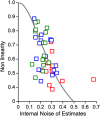Location- and object-based attention enhance number estimation
- PMID: 33156512
- PMCID: PMC7875840
- DOI: 10.3758/s13414-020-02178-w
Location- and object-based attention enhance number estimation
Abstract
Humans and non-humans can extract an estimate of the number of items in a collection very rapidly, raising the question of whether attention is necessary for this process. Visual attention operates in various modes, showing selectivity both to spatial location and to objects. Here, we tested whether each form of attention can enhance number estimation, by measuring whether presenting a visual cue to increase attentional engagement will lead to a more accurate and precise representation of number, both when attention is directed to location and when it is directed to objects. Results revealed that enumeration of a collection of dots in the location previously cued led to faster, more precise, and more accurate judgments than enumeration in un-cued locations, and a similar benefit was seen when the cue and collection appeared on the same object. This work shows that like many other perceptual tasks, numerical estimation may be enhanced by the spread of active attention inside a pre-cued object.
Keywords: Bayesian modelling; Object-based attention.
Figures







Similar articles
-
Deficiency of object-based attention specific to the gaze cue is independent of top-down attentional strategies.Perception. 2023 May;52(5):330-344. doi: 10.1177/03010066231168570. Epub 2023 Apr 20. Perception. 2023. PMID: 37078155
-
Eye gaze versus arrows as spatial cues: two qualitatively different modes of attentional selection.J Exp Psychol Hum Percept Perform. 2012 Apr;38(2):326-35. doi: 10.1037/a0023959. Epub 2011 Jun 20. J Exp Psychol Hum Percept Perform. 2012. PMID: 21688940
-
The flickering spotlight of visual attention: Characterizing abnormal object-based attention in schizophrenia.Schizophr Res. 2022 Oct;248:151-157. doi: 10.1016/j.schres.2022.08.020. Epub 2022 Sep 2. Schizophr Res. 2022. PMID: 36063606 Free PMC article.
-
Temporal estimation with two moving objects: overt and covert pursuit.Exp Brain Res. 2015 Jan;233(1):253-61. doi: 10.1007/s00221-014-4110-y. Epub 2014 Sep 30. Exp Brain Res. 2015. PMID: 25266716
-
Distributed versus focused attention (count vs estimate).Wiley Interdiscip Rev Cogn Sci. 2011 Nov;2(6):634-638. doi: 10.1002/wcs.136. Epub 2010 Dec 23. Wiley Interdiscip Rev Cogn Sci. 2011. PMID: 22121459 Free PMC article. Review.
Cited by
-
Serial dependence bias can predict the overall estimation error in visual perception.J Vis. 2023 Nov 1;23(13):2. doi: 10.1167/jov.23.13.2. J Vis. 2023. PMID: 37917052 Free PMC article.
-
The Grouping-Induced Numerosity Illusion Is Attention-Dependent.Front Hum Neurosci. 2021 Oct 6;15:745188. doi: 10.3389/fnhum.2021.745188. eCollection 2021. Front Hum Neurosci. 2021. PMID: 34690725 Free PMC article.
-
Visual field asymmetries in numerosity processing.Atten Percept Psychophys. 2022 Nov;84(8):2607-2622. doi: 10.3758/s13414-022-02585-1. Epub 2022 Oct 18. Atten Percept Psychophys. 2022. PMID: 36258143 Free PMC article.
-
Implicit visuospatial attention shapes numerosity adaptation and perception.J Vis. 2021 Aug 2;21(8):26. doi: 10.1167/jov.21.8.26. J Vis. 2021. PMID: 34448819 Free PMC article.
-
Adaptation biases the parallel perception of subitized numerosities.Sci Rep. 2024 Oct 29;14(1):26014. doi: 10.1038/s41598-024-76536-1. Sci Rep. 2024. PMID: 39472716 Free PMC article.
References
-
- Agrillo, C., & Bisazza, A. (2014). Spontaneous versus trained numerical abilities. A comparison between the two main tools to study numerical competence in non-human animals. Journal of Neuroscience Methods. 10.1016/j.jneumeth.2014.04.027 - PubMed
-
- Alvarez, G. A. (2011). Representing multiple objects as an ensemble enhances visual cognition. Trends in Cognitive Sciences. 10.1016/j.tics.2011.01.003 - PubMed
-
- Anobile, Giovanni, Cicchini, G. M., & Burr, D. C. (2012a). Linear mapping of numbers onto space requires attention. Cognition. 10.1016/j.cognition.2011.11.006 - PubMed
-
- Anobile, Giovanni, Stievano, P., & Burr, D. C. (2013). Visual sustained attention and numerosity sensitivity correlate with math achievement in children. Journal of Experimental Child Psychology. 10.1016/j.jecp.2013.06.006 - PubMed
MeSH terms
Grants and funding
LinkOut - more resources
Full Text Sources

